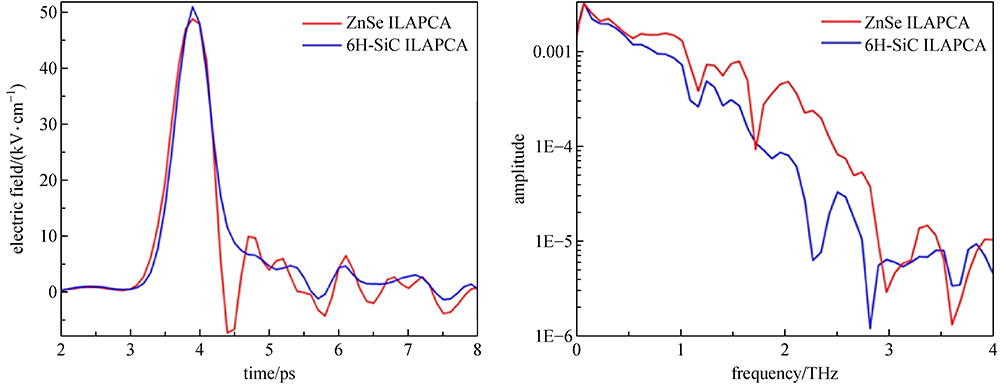Photoconductive emitters with large photo-excited surfaces and simple strip-line electrodes are a simple way to improve the peak electric field of THz pulses by increasing the total excited area but keeping the same optical fluence as in conventional PCAs [
34,
35,
38,
39]. The typical emitting surface of LAPCAs can vary from hundreds of mm
2 to a few tens of cm
2. The electrode gap size of these emitters is much larger than the wavelength of the emitted THz pulses, with spacing between the electrodes ranging from 1 mm to 1 cm [
34,
40,
41]. Semi-large PCAs have an inter-electrode distance much smaller than the LAPCA, and sometimes the gap size is equivalent to the emitted wavelength ranging from a few hundred μm to 1 mm. However, for semi-large PCA, the theory, described in the introduction, remains the same. The schematic diagram of a conventional LAPCA is shown in Fig. 1. To take full advantage of the large area of these emitters, we need to work with a large laser beam, which in turn requires higher energy. The consequence will be an injection of a larger number of carriers, which results in a larger radiated electric field. Further, unlike micro-dipole photoconductive emitters, LAPCAs do not suffer from the space-charge-field screening effect [
42], which is one of the saturation effects limiting the intensity of the THz pulses. The origin of this effect can be explained by the separation of free charges (electron-hole) in the semiconductor. These free carriers are accelerated under the applied bias field, thus generating a static Coulomb field, which is in the opposite direction of the bias field and ultimately causes partial screening of the applied bias fields in the ps timescale [
42,
43]. Using Monte-Carlo simulations, it was also shown that in GaAs, space charge is almost negligible when the inter-electrode spacing is larger than 100 µm [
42]. Studies have shown that the choice of the semiconductor substrate greatly influences the performances of the LAPCAs. Usually, for the generation of high-intensity THz pulses, it is preferable to work with a semiconductor substrate with high dielectric strength, excellent thermal properties and high carrier mobility [
35,
44–
48]. From this perspective, the first intense THz source using a LAPCA was demonstrated by You et al. [
39]. In their study, two aluminum electrodes were fabricated on opposite sides of a GaAs substrate with a dimension of 3.5 cm × 3.5 cm. This emitter generated THz pulses with an energy of 0.8 µJ when illuminated with an excitation fluence of 40 µJ/cm
2 and an applied bias field of 10.7 kV/cm. With its calculated peak THz electric field of 150 kV/cm and optical-to-THz conversion efficiency of 1.6×10
−3, this source can be considered as one of the most effective LAPCA THz sources to date. Another early demonstration of THz wave generation from low-temperature grown (LT) GaAs LAPCA was performed by Darrow et al
. [
14]. With a photoconductive gap of 0.5 mm, the antenna was excited by a mode-locked ring dye laser with pulse energy and a duration of 8 µJ and 70 fs, respectively, at a central wavelength of 618 nm. The waveform of radiated THz pulses from the antenna was a quasi-half cycle with a duration of 600 fs FWHM. The scaling of the THz radiated field as a function of the optical excitation fluence was studied with increasing applied bias fields from 1.0 to 4.0 kV/cm (Fig. 2). For high fluence excitations of 1 mJ/cm
2, a strong saturation behavior in the peak amplitude of the THz fields was observed for all values of the applied bias fields. Further, increasing the bias field up to 5 kV/cm caused thermal damage at an optical fluence of 1 mJ/cm
2. Experimental studies performed on the LAPCAs using semi-insulating (SI) GaAs, InP and ZnSe substrates have shown that the screening of the bias field appears for all types of antennas and all bias field when they are excited with a high optical fluence, relative to the saturation fluence, and with photon energy that is higher than the semiconductor bandgap [
18,
49–
51]. From this perspective, we can clearly see that increasing the optical fluence leads to the saturation of the THz field. The advantage of working within the screening regime is that the LAPCA will have less fluctuation in the radiated field. This is especially true when these LAPCA are pumped with an amplified laser with a very low repetition rate. In this case, one way to increase the intensity of the THz pulses is to increase the bias field. A recent theoretical study has shown that an applied external magnetic field parallel to the electrode direction can also be an effective solution to increase the maximum intensity of the THz pulses radiated by LAPCAs [
52].





























